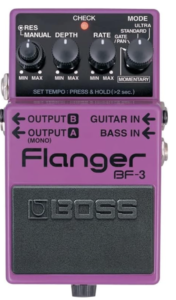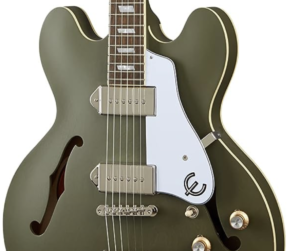In the world of guitar playing, there exists a multitude of techniques that lend their unique flavors to the instrument’s sonic palette. Among these, palm muting stands out as a versatile and essential tool for players across genres.
From the aggressive chug of metal riffs to the subtle percussive accents of acoustic ballads, palm muting adds depth, dynamics, and definition to a guitarist’s arsenal.
What is Palm Muting?
 Palm muting is a technique wherein the palm of the picking hand is lightly rested against the strings near the bridge of the guitar. This dampens the vibrations of the strings, resulting in a muted, percussive sound. While primarily associated with electric guitar playing, it can also be effectively utilized on acoustic guitars, albeit with slightly different tonal characteristics.
Palm muting is a technique wherein the palm of the picking hand is lightly rested against the strings near the bridge of the guitar. This dampens the vibrations of the strings, resulting in a muted, percussive sound. While primarily associated with electric guitar playing, it can also be effectively utilized on acoustic guitars, albeit with slightly different tonal characteristics.
How to Palm Mute
To execute palm muting effectively, follow these steps:
- Hand Positioning: Begin by placing your picking hand over the strings, with your palm resting lightly on or just before the bridge. Experiment with different angles and positions to find the sweet spot where the strings are sufficiently muted without being completely choked.
- Pressure Control: Apply just enough pressure with your palm to dampen the strings without completely stifling their vibration. Too much pressure will result in a dull, lifeless sound, while too little will allow the strings to ring freely.
- Experiment with Pick Attack: Vary the intensity of your pick attack to achieve different levels of palm-muted sound. A softer touch will yield a more subtle, percussive effect, while a heavier attack will produce a more aggressive, driving sound.
- String Selection: Palm muting is most commonly applied to the lower strings (E, A, and D), particularly in genres like rock and metal where rhythmic power and punch are emphasized. However, don’t hesitate to experiment with muting the higher strings as well, as this can add interesting textures and nuances to your playing.
- Combine with Open Chords and Power Chords: Practice incorporating the technique into chord progressions, both with open chords and power chords. Experiment with different strumming patterns and rhythmic variations to discover the full expressive potential of the technique.
Also Read:
Ibanez RGT1270PB Guitar Review
100 Best Guitar Brands for 2024
10 Best Flanger Guitar Pedals for 2024
Applications of Palm Muting
Palm muting finds widespread use across a variety of musical genres and playing styles:
- Rock and Metal: In genres characterized by heavy distortion and aggressive riffing, such as rock and metal, palm muting is employed to create tight, percussive rhythms that drive the music forward. From palm-muted power chord progressions to lightning-fast palm-muted gallops, this technique forms the backbone of many iconic guitar riffs.
- Punk and Hardcore: Punk and hardcore guitarists use palm muting to inject energy and intensity into their playing, often combining it with rapid-fire downstrokes to create a relentless, propulsive sound.
- Funk and R&B: In funk and R&B music, it is utilized to achieve a crisp, staccato effect that adds groove and rhythmic punch to chord progressions and single-note lines.
- Acoustic Singer-Songwriter: Even in more subdued acoustic contexts, it can be employed to add subtle percussive accents and dynamic contrast to fingerpicked patterns and chord progressions.
Mastering Palm Muting
 Like any guitar technique, mastering this technique requires patience, practice, and a keen ear for nuance. Start by practicing simple exercises, gradually increasing the tempo and complexity as your comfort level grows. Record yourself practicing and listen back critically to refine your technique and ensure consistency of tone and timing.
Like any guitar technique, mastering this technique requires patience, practice, and a keen ear for nuance. Start by practicing simple exercises, gradually increasing the tempo and complexity as your comfort level grows. Record yourself practicing and listen back critically to refine your technique and ensure consistency of tone and timing.
Above all, don’t be afraid to experiment and make the technique your own. Palm muting is a highly versatile tool that can be adapted and applied in countless ways to suit your musical vision and creative expression.
So grab your guitar, palm mute away, and unlock the rhythmic power and sonic depth that this essential technique has to offer.
Exploring Palm Muting: Techniques and Variations
 Beyond the basics, there are several advanced techniques and variations of palm muting that players can explore to further enhance their musical expression:
Beyond the basics, there are several advanced techniques and variations of palm muting that players can explore to further enhance their musical expression:
- Halfway Muting: Instead of fully resting the palm on the strings, try hovering it slightly above the strings while still making contact. This produces a more subtle muting effect, allowing some of the string’s natural resonance to come through while still dampening excessive ringing. Halfway muting is particularly effective for adding texture and dimension to clean and lightly distorted tones.
- Palm Muting with Chords: Experiment while playing chord voicings beyond the typical power chords. Try incorporating muted strums into open chord progressions, arpeggiated chord patterns, and extended chord voicings. This adds a percussive, rhythmic quality to your chordal playing and can help create dynamic contrast within a song.
- Dynamic Control: Develop your ability to control the intensity of your technique dynamically. Practice gradually increasing or decreasing the pressure of your palm on the strings to smoothly transition between muted and unmuted passages. This level of dynamic control adds depth and expressiveness to your playing, allowing you to craft nuanced performances that ebb and flow with emotion.
- Palm Muting in Lead Playing: While palm muting is most commonly associated with rhythm guitar playing, it can also be effectively incorporated into lead guitar lines and solos. Experiment with adding brief palm-muted notes or phrases within your lead lines to create rhythmic accents and enhance their impact. This technique is particularly effective in genres like blues and rock, where a combination of lead and rhythm playing is common.
- Combining Palm Muting with Other Techniques: Get creative by combining it with other guitar techniques such as hammer-ons, pull-offs, slides, and bends. Experiment with incorporating muted and unmuted passages within the same phrase or riff to create dynamic contrast and interest. The possibilities are virtually limitless, so don’t hesitate to explore different combinations to discover unique sounds and textures.
Palm Muting Tips and Tricks
- Experiment with Different Pickups: The tonal character of palm muting can vary depending on which pickup (or combination of pickups) you use on your electric guitar. Try experimenting with different pickup settings to find the combination that best complements your palm-muted sound.
- Use a Metronome: Practicing with a metronome is crucial for developing tight rhythm and timing. Start at a comfortable tempo and gradually increase the speed as you become more proficient. Focus on maintaining consistency and precision in your palm muting technique, even at faster tempos.
- Listen to Examples: Study recordings of your favorite guitarists across various genres to observe how they use palm muting in their playing. Pay attention to the nuances of their technique, such as the degree of palm pressure, pick attack, and rhythmic placement. Analyzing and emulating these nuances can help you refine your own palm muting skills.
In conclusion, palm muting is a fundamental technique that every guitarist should master. Its versatility and expressive potential make it an indispensable tool for shaping the dynamics and texture of your playing. By incorporating the techniques, variations, and tips outlined above into your practice routine, you can unlock the full creative potential of palm muting and take your guitar playing to new heights.
